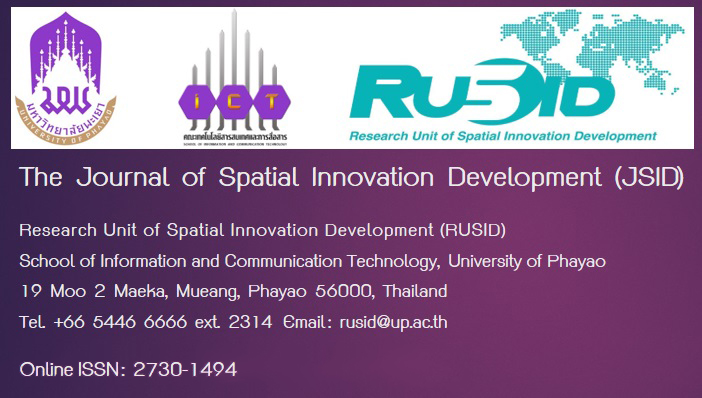The Development of Online Lessons on Data and Data Collection for Matthayom Sueksa 1 based on MIAP Learning Model
Keywords:
Online Lessons, Data and Data Collection, Inquiry Cycles MIAPAbstract
This study aimed to: 1) develop an online lesson on “Data and Data Collection” using the MIAP model for Matthayom Sueksa 1 students, with an efficiency of 80/80 as the predetermined criterion, 2) evaluate the appropriateness of the developed online lesson, 3) compare the learning achievement of students using the developed lesson, and 4) examine students' satisfaction with the lesson. The sample group consisted of 29 Matthayom Sueksa 1/3 students from Phuengdaet Wittayakarn School, Mukdahan Province, selected through cluster random sampling using a lottery method, with class sections as the sampling units. The research instruments included the online lesson, an appropriateness evaluation form, worksheets, an achievement test, and a satisfaction questionnaire. Data were analyzed using mean, percentage, standard deviation, efficiency values, and t-tests.
The results showed that: 1) the developed online lesson consisted of two components: 1.1) the learner component and 1.2) the administrator component, and its efficiency was 80.33 / 83.67, which met the set criterion of 80/80; 2) the overall appropriateness of the developed online lesson was rated at a high level ( = 4.48, S.D. = 0.55); 3) the post-test scores were significantly higher than the pre-test scores at the .01 level; and 4) the overall student satisfaction with the online lesson was at the highest level (
= 4.71, S.D. = 0.47).
References
กระทรวงศึกษาธิการ. (2560). ตัวชี้วัดและหลักสูตรแกนกลางกลุ่มสาระการเรียนรู้วิทยาศาสตร์ และเทคโนโลยี(ฉบับปรับปรุง พ.ศ. 2560) ตามหลักสูตรแกนกลางการศึกษาขั้นพื้นฐาน พุทธศักราช 2551. กรุงเทพฯ: โรงพิมพ์ชุมนุมสหกรณ์การเกษตรแห่งประเทศไทยจํากัด.
สถาบันส่งเสริมการสอนวิทยาศาสตร์และเทคโนโลยี. (2560). หนังสือเรียน รายวิชาพื้นฐาน วิทยาการคำนวณ มัธยมศึกษาปีที่ 1. กรุงเทพฯ: สำนักงานคณะกรรมการการศึกษาขั้นพื้นฐาน.
กาญจน์ กันปัญญา, จิระยุทธ เนื่องรินทร์ และ อนุมัติ ศิริเจริญพานิชย์. (2565). การพัฒนาเทคนิครูปแบบการสอนแบบผสมผสานด้วยกระบวนการเรียนของ MIAP รายวิชาปฏิบัติงานเครื่องยนต์เล็ก และจักรยานยนต์สำหรับนักศึกษาระดับปริญญาตรี. วารสารชุมชนวิจัย และพัฒนาสังคม, 16(2), 108-120.
ขจรพงษ์ พู่ภมรไกรภพ. (2562). MIAP กับการจัดการเรียนรู้ระดับอาชีวศึกษา. วารสารวิจัย และนวัตกรรมสถาบันการอาชีวศึกษากรุงเทพมหานคร, 2(2), 14-21.
ชัยยงค์ พรหมวงค์. (2548). ระเบียบวิธีวิจัยเพื่อพัฒนานวัตกรรมการเรียนรู้. กรุงเทพฯ: สำนักพิมพ์แห่งจุฬาลงกรณ์มหาวิทยาลัย.
ณัฐพล ธนชเวงสกุล และนามน จิรังสุวรรณ. (2561). การออกแบบรูปแบบการเรียนการสอนด้วยกระบวนการเรียนรู้แบบ MIAP บนเทคโนโลยีการประมวลผลแบบคลาวด์ของนักศึกษาระดับปริญญาตรี เพื่อส่งเสริมทักษะการเรียนรู้ในศตวรรษที่ 21. วารสารการศึกษาและนวัตกรรม, 20(4), 58–69. สืบค้นจาก https://so06.tci-thaijo.org/index.php/edujournal_nu/article/view/67630.
นีรนาท จุลเนียม. (2562). การพัฒนารูปแบบการเรียนร่วมกับสื่อเครือข่ายสังคมออนไลน์ เพื่อพัฒนาทักษะการคิด อย่างมีวิจารณญาณของนักศึกษาระดับบัณฑิตศึกษาโดยใช้กระบวนการเรียนรู้แบบMIAP. วารสารศึกษาศาสตร์ มมร, 7(2), 319-334.
บุญชม ศรีสะอาด. (2542). การวิจัยเบื้องต้น. กรุงเทพฯ: สุวีริยาสาส์น.
บุญทัน ดอกไธสง. (2562). สถิติและการวิจัยทางการศึกษา. กรุงเทพฯ: สำนักพิมพ์จุฬาลงกรณ์มหาวิทยาลัย.
ฤทัย ประทุมทอง และ ทรงนคร การนา. (2565). การพัฒนาชุดการสอน เรื่อง การเขียนคำสั่งพื้นฐาน วิชาโปรแกรมเมเบิลคอนโทรลเลอร์เบื้องต้นด้วยกระบวนการเรียนรู้แบบ MIAP ร่วมกับการสอนโดยใช้เกมสำหรับนักเรียนระดับประกาศนียบัตรวิชาชีพชั้นปีที่ 2 สาขาวิชา ช่างเมคคาทรอนิกส์. วารสารศึกษาศาสตร์มหาวิทยาลัยสงขลานครินทร์ วิทยาเขตปัตตานี, 33(2), 141-156.
วรพจน์ ศรีวงษ์คล. (2554). เทคนิคการสอนแบบ MIAP ให้ประสบความสำเร็จ. สืบค้นจาก https://fte.kmutnb.ac.th/wp-content/uploads/2021/km/เทคนิคการสอนแบบ%20MIAP%20ให้ประสบความสำเร็จ%20รศ%20วรพจน์.pdf.
สำนักงานเลขาธิการสภาการศึกษา. (2560). แผนการศึกษาแห่งชาติ พ.ศ. 2560-2579. กรุงเทพฯ: กระทรวงศึกษาธิการ.
สุมาลี สิกเสน. (2562). การพัฒนาผลสัมฤทธิ์ทางการเรียนโดยใช้บทเรียนออนไลน์ เรื่อง การสร้างภาพเคลื่อนไหวร่วมกับ การจัดการเรียนการสอนแบบห้องเรียนกลับด้านสำหรับนักศึกษาระดับปริญญาตรี มหาวิทยาลัยราชภัฏ นครปฐม. วารสารศึกษาศาสตร์มหาวิทยาลัยศิลปากร, 17(2), 239-252.
สุราษฎร์ พรมจันทร์. (2556). การเรียนการสอนรูปแบบ MIAP. สืบค้นจาก https://www.slideshare.net/drpanita/4-miap.
กาญจน์ กันปัญญา, จิระยุทธ เนื่องรินทร์ และ อนุมัติศิริ เจริญพานิชย์. (2022). การพัฒนาเทคนิครูปแบการสอนแบบผสมผสานด้วยกระบวนการเรียนของ MIAP รายวิชาปฏิบัติงานเครื่องยนต์เล็ก และจักยานยนต์ สำหรับนักศึกษาระดับปริญญาตรี. วารสารชุมชนวิจัย และพัฒนาสังคม,16(2), 108-120.
Branch, R. M. (2009). Instructional design: The ADDIE approach. Springer.
Dick, W., Carey, L., & Carey, J. O. (2005). The systematic design of instruction (6th ed.). Pearson.
Garrison, D. R., Anderson, T., & Archer, W. (2000). Critical inquiry in a text-based environment: Computer conferencing in higher education. The Internet and Higher Education, 2(2-3), 87–105. Form https://doi.org/10.1016/S1096-7516(00)00016-6.
Laohajaratsang, T. (2020). Online learning design and development. Educational Technology Journal, 15(2), 25-40.
Molenda, M. (2003). In search of the elusive ADDIE model. Performance Improvement, 42(5), 34-36. form
https://doi.org/10.1002/pfi.4930420508HTTP Status 429.
Na Songkhla, J. (2021). Interactive online learning environments: Principles and practices. Journal of Education Studies,
(3), 112-128.
Ratanapiern, W. (2022). Systematic approach to e-learning development. Digital Learning Review, 12(1), 45-62.
UNESCO. (2020). Education in a post-COVID world: Nine ideas for public action. UNESCO.




